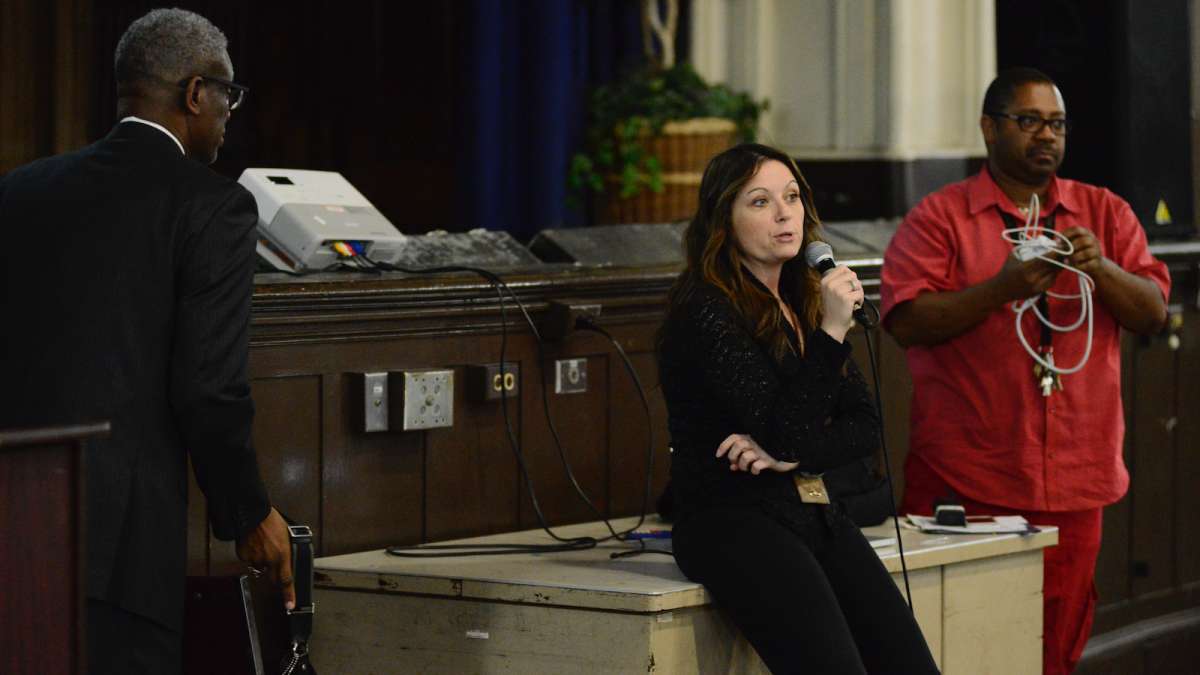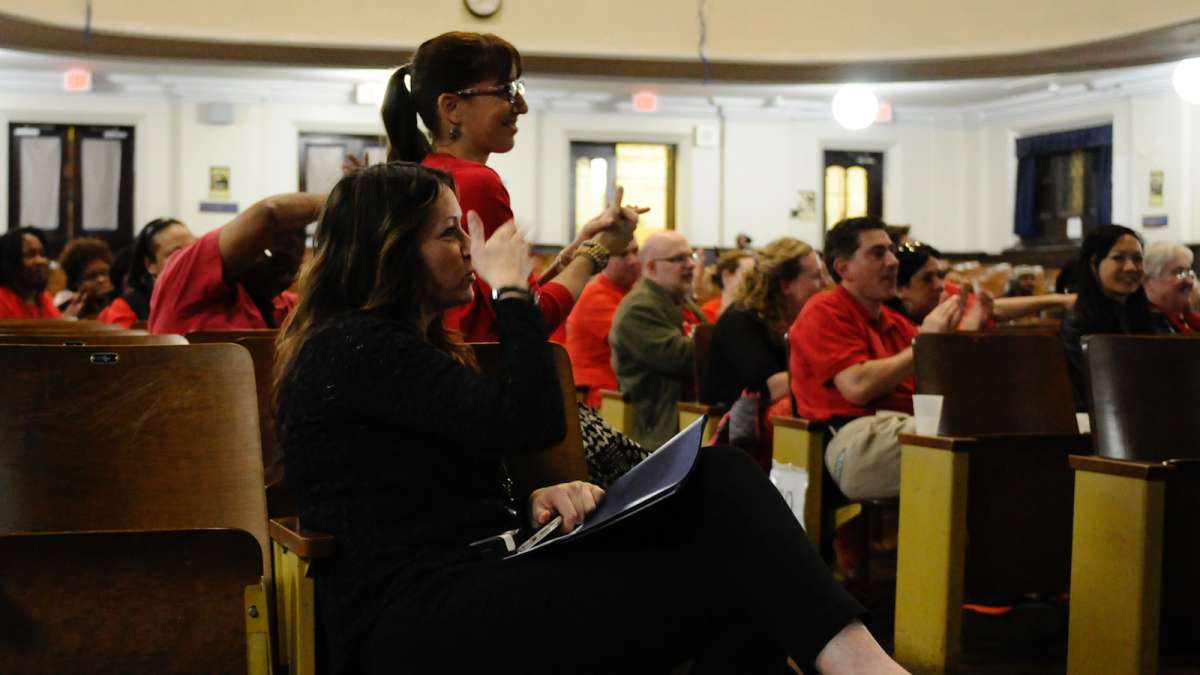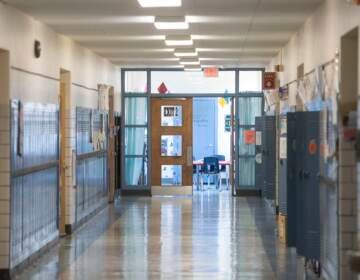Educators push back against Philly district plan for school shake-ups
ListenThe School District of Philadelphia is devoting $23.7 million to a new plan for intervention at 15 of its lowest-performing schools; $7.2 million of that is new district investment. The rest will come from redirecting funds currently spent at affected schools.
The district will provide additional resources and supports to the schools clustered in its “Turnaround Network” with a goal of lifting them out of the bottom quartile of the district’s quality rating within five years.
Until this point, the Turnaround Network has consisted of the 12 remaining schools that were designated “promise academies” by former Superintendent Arlene Ackerman in 2010.
As reported last week, the district plans to add four of its academically lowest-ranking elementary schools to the list: Theodore Roosevelt, E.W. Rhodes, S. Weir Mitchell, and Luis Munoz-Marin.
And it has plans to remove Cayuga Elementary from the Turnaround Network based on student growth on state standardized tests.
District officials said all of the turnaround schools will have an assistant principal, a full-time guidance counselor, and full-time teacher coaches for English and math.
Officials said K-2 classrooms will be capped at 20-1 student-teacher ratios; teachers and principals will receive extensive professional development; and technology-driven blended-learning models will be put at a premium.
“Our whole notion of this is creating great schools and great educational opportunities for all students using a set of proven tools,” said Superintendent William Hite during a meeting with reporters Wednesday.
Hite couched the plan, in part, as a response to critics who say the district too often outsources its lowest-performing schools to charter organizations through the Renaissance process.
“When we did Renaissance several years ago, and recommended Renaissance this year, the first questions people asked were: ‘Why doesn’t the district do this work?’ And now the district is attempting to do this work.”
Hite said this model would accelerate student achievement where the promise academies have failed.
In that intervention model, schools were initially given a bounty of added resources, and staff received extra pay to work longer hours and some Saturdays.
The district recognized that those turnaround attempts faltered after the first year when budget woes undermined the effort for a plethora of reasons.
“A lot of those strategies were based on extra stuff …” said Hite. “It was less on the science of reading, or teaching reading. So all of the extra things were then removed, and there was nothing there behind those things to continue that improvement.”
The district’s plan hinges on recieving added funding as proposed by Gov. Tom Wolf.
Half gone?
At the four newly selected schools, principals and staff will be required to reapply for their jobs.
Based on eligibility for state and federal turnaround grants, the district said it will allow no more than half of the current staff to stay at the schools. Teachers not chosen through a turnaround school’s site-selection process would be force transferred elsewhere in the district.
District officials could not confirm the level of turnaround-grant funding fo which they could be eligible.
But the Philadelphia Federation of Teachers has joined traditional education advocates in decrying this as a “destabilization plan.”
“It’s the old ‘We under-resource the school, we blame the school for not having high performance, and we then get rid of the school or get rid of the staff,'” said union president Jerry Jordan.
Hite dismissed that criticism.
“We’re not trying to destabilize the schools. We’re trying to stabilize the schools and move forward,” he said. “In some cases, just the introduction of a new approach could destabilize. So it’s important to understand if individuals are on board or not.”
Hite also indicated flexibility on the 50 percent transfer provision.
Although he said that he didn’t “want to do anything that doesn’t make us eligible for federal or state monies for school turnaround,” and that there “has been no proof” that existing faculty can dramatically improve outcomes, he later added that he would entertain proposals from principals who pushed back.
At a community meeting at S. Weir Mitchell Elementary in Southwest Philadelphia Wednesday evening, first-year principal Stephanie Andrewlevich — recognized by district officials as a strong, capable leader — said she had conditions for returning to the school.
“I have made it very clear that if I am offered to remain, that will only happen if we have the ability to retain our staff,” Andrewlevich told the few dozen people gathered in Mitchell’s auditorium. “If 50 percent of our staff is asked to leave, then all the work that we have done in the last year is nullified.”
“I’ve never been around a group of people who love your children the way these individuals do,” she continued. “They make their mistakes. They’re not perfect. But they love your children.”
In a follow-up interview, Andrewlevich acknowledged that the school could improve with limited turnover.
“There are some staff members that I have had hard conversations with — before the turnaround model [was announced] — that maybe this is not the right fit for you,” she said. “But that’s a very small percentage. I would say that 85 percent of our staff are not only committed, but are the right fit for Mitchell.”
Numerous parents and advocates at the meeting questioned Assistant Superintendent Eric Becoats about how the staff shakeup would benefit students.
Parent Ieisha Smith — whose seven children are either current or former Mitchell students — offered particularly rousing testimony against the need for turning over faculty.
“I love the fact that you want to give us stuff. We need it. Believe that. The whole district does,” she said. “But if you’re going to give it to us, give it to us. Don’t give us stipulations on getting it. We need it, period.”
Smith criticized the district for closing nearby schools in recent years and then expanding Mitchell from a K-5 to a K-8 without providing all of the needed supports.
She said the school was just beginning to stabilize under the tenure of Andrewlevich.
“We need everybody in here to stay in place because our kids are going to wile out even more when you change the atmosphere,” she said.
More pushback expected
In response to Smith and other speakers, Becoats said it was important for all staff working in turnaround schools to embrace and support the philosophies and demands of the turnaround model.
As for why no more than 50 percent of the staff would be allowed to return, he said that is “the process that we’re using.”
“We’re following, in some regards, what’s in a book,” he said, holding a up a copy of the district’s contract with the Philadelphia Federation of Teachers.
The PFT contract says:
“Once a school has been designated as a Renaissance School, all teachers in the school shall become forced transfers and up to fifty percent (50%) of those teachers that apply to the school through the site selection process may be rehired.”
District officials say they believe they can only give principals autonomy to reconstitute all or some of a school’s staff by invoking this provision.
Jordan disagrees with the premise.
He questioned the need for further staff turnover at these schools because each has already seen dramatic staffing shakeups in the last few years.
If the district deems a new turnaround plan necessary, he said he wishes officials would take a friendlier tack.
“Go in. Discuss the program, and say to people, we would like you to be apart of this program, but we understand if you can’t or don’t want to, and you will have the opportunity to be transferred out,” said Jordan. “It’s a very different message.”
Staff at other schools are expected to push back against the district’s plans as well. At Luis Munoz Marin, which saw drastic staffing turnover in September 2014, teachers have been planning vigorous opposition.
At Mitchell, principal Andrewlevich offered no illusions about the difficulty and seriousness of the work that needs to be done.
“We need help. Our instruction needs to change. Our data is real. We are declining. I’m not going to say that’s not happening,” she said.
But she could not fathom how that task would become easier by forcing out half of her staff.
“If they leave, chances are they are going to go to a school ranked above us — because there’s only three below us — and they don’t want to leave,” she said. “If that doesn’t tell you what we have here, nothing does.”
WHYY is your source for fact-based, in-depth journalism and information. As a nonprofit organization, we rely on financial support from readers like you. Please give today.













